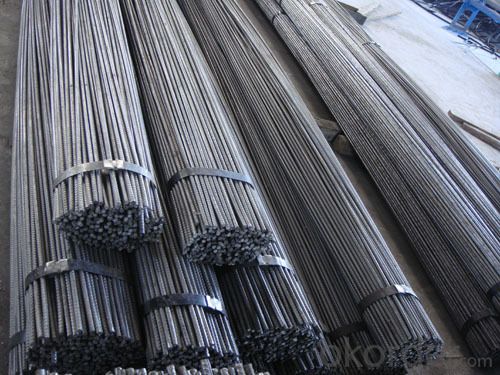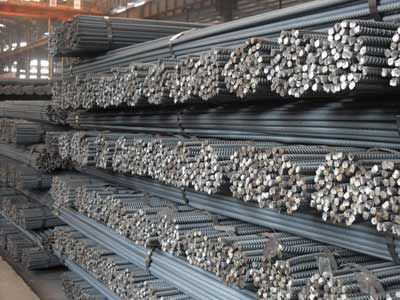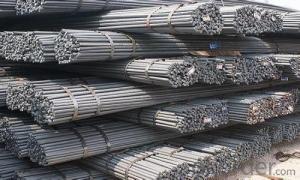HDC stainless deformed steel bar for construction
- Loading Port:
- Tianjin
- Payment Terms:
- TT OR LC
- Min Order Qty:
- 25 m.t.
- Supply Capability:
- 100000 m.t./month
OKorder Service Pledge
OKorder Financial Service
You Might Also Like
Specifications of Construction Steel Round Bar
1. Grade: Q195, Q235, A36, SS400, Q345
2. Material: Mild carbon steel
3. Diameter: 8mm-150mm
4. Length: 6m, 9m, 12m
5. Quenching methods: oil quenching, air cooling or salt bath quenching
6. Heat treatment: Isothermal annealing temperature is 800~880 °C, with 10~20 °C, the furnace cooling to about 600 °C
Usage and Applications of Construction Steel Round Bar
1. Construction steel round bar is mostly used for straight bundles supply, and used for steel, bolts and various mechanical parts. While the bigger round bar, or more than 25mm hot rolled bar, is mainly for the manufacture of mechanical parts or for seamless steel billet.
2. Steel round bar is used in construction and a large number of architectural and engineering structures.
3. Besides, we can supply some especial material steel round bar that can be used for main shaft of steamer, hummer shank, with big section and supper force.
Production Flow of Mild Steel Round Bar
EAF+LF+VD+ Forged+ Heat Treatment
Material prepare (billet) — heat up — rough rolling — precision rolling — cooling — packing — storage and transportation
Quality Assurance of Mild Steel Round Bar
1. We will strictly inspect our production that we sold according to the customer’s request.
2. Our steel reaches international quality standards.
3. Quality should be in conformity with the specification of the manufacturer. Quantity and packing conditions should be in conformity with the term in the contract.
4. Should the packing found damaged, the buyer has the right to claim to the seller.



- Q:What are the common types of coatings applied to steel rebars for corrosion protection?
- The common types of coatings applied to steel rebars for corrosion protection include epoxy, zinc, and polyethylene.
- Q:The difference between round face and round bar steel on concrete
- The difference between round bar and round bar is that the surface has longitudinal ribs and transverse ribs, usually with two longitudinal ribs and transverse ribs uniformly distributed along the length direction. The rebar is a kind of small section steel, mainly used for the skeleton of reinforced concrete construction members. In use, some mechanical strength, bending deformation property and welding performance are required. The raw steel billet for the production of threaded steel is carbon structural steel or low alloy structural steel which is treated by calm melting, and the finished steel bar is delivered in hot rolling forming, normalizing or hot rolling state.
- Q:What are the advantages of using corrosion-resistant steel rebars?
- Corrosion-resistant steel rebars offer numerous benefits in construction projects. Firstly, they provide enhanced durability and longevity. Unlike regular steel rebars, which corrode easily when exposed to moisture and chemicals, corrosion-resistant steel rebars are designed to resist corrosion, ensuring a longer lifespan for the structure. This is especially advantageous in high-humidity environments, coastal areas, or regions with high pollution levels. Secondly, the use of corrosion-resistant steel rebars helps maintain the structural integrity of the building. Corrosion weakens rebars, leading to structural failures and safety hazards. However, by using corrosion-resistant steel rebars, the risk of corrosion-induced structural damage is minimized, ensuring the safety of occupants and the overall stability of the structure. Furthermore, the maintenance costs associated with corrosion-resistant steel rebars are significantly lower compared to regular steel rebars. Structures built with regular steel rebars require frequent inspections, repairs, and maintenance to prevent and address corrosion issues. However, corrosion-resistant steel rebars reduce the need for such maintenance, resulting in reduced costs over the structure's lifespan. Moreover, corrosion-resistant steel rebars offer increased flexibility in design and construction. These rebars possess properties that allow for the construction of thinner and lighter structures without compromising strength. This can lead to cost savings in terms of materials and construction time, making corrosion-resistant steel rebars a cost-effective solution. Lastly, the use of corrosion-resistant steel rebars contributes to sustainable construction practices. By increasing the structure's lifespan and reducing the need for maintenance, the environmental impact of the construction project is minimized. Additionally, the use of these rebars can contribute to obtaining green building certifications, promoting sustainable and environmentally-friendly construction practices. In conclusion, the advantages of corrosion-resistant steel rebars include enhanced durability, improved structural integrity, reduced maintenance costs, increased design flexibility, and the promotion of sustainable construction practices.
- Q:What are the advantages of using stainless steel rebars?
- Using stainless steel rebars in construction projects offers several advantages. Firstly, these rebars have a remarkable resistance to corrosion, making them perfect for structures in harsh environments such as coastal or industrial areas. Unlike traditional carbon steel rebars, stainless steel rebars do not easily rust or corrode, ensuring the durability and longevity of the structure. Secondly, stainless steel rebars possess a higher tensile strength compared to carbon steel rebars. This means they can endure greater stress and loads without deforming or breaking, resulting in a safer and more reliable structure. Moreover, their high tensile strength allows for the utilization of smaller rebars, which saves construction costs and reduces the overall weight of the structure. Furthermore, stainless steel rebars exhibit excellent fire resistance properties. They retain their strength and integrity much better than carbon steel in the event of a fire, reducing the risk of structural collapse. This is particularly crucial in buildings with high fire safety requirements, such as hospitals, schools, and high-rise structures. Another advantage of stainless steel rebars is their low maintenance requirements. Due to their corrosion resistance, they do not need regular inspections or costly protective coatings. This saves both time and money in maintenance efforts. Lastly, stainless steel rebars are highly sustainable and environmentally friendly. They are 100% recyclable, reducing the demand for new raw materials and minimizing waste in construction projects. Additionally, the long lifespan of stainless steel rebars reduces the need for frequent replacements, further minimizing the environmental impact. To summarize, the benefits of using stainless steel rebars include excellent corrosion resistance, high tensile strength, superior fire resistance, low maintenance requirements, and sustainability. These advantages make stainless steel rebars the preferred choice for construction projects that prioritize durability, safety, and long-term value.
- Q:Can steel rebars be used in highway barrier construction?
- Yes, steel rebars can be used in highway barrier construction. Steel rebars are commonly used as reinforcement in concrete structures, including highway barriers. They provide strength and durability to the barriers, making them capable of withstanding the impact of vehicles and preventing them from crossing into opposing lanes or off the road. Steel rebars are known for their high tensile strength and excellent resistance to corrosion, which are crucial properties for highway barriers that are constantly exposed to harsh weather conditions and heavy traffic loads. Additionally, steel rebars are readily available and cost-effective, making them a preferred choice for highway barrier construction.
- Q:What are the different methods of joining steel rebars?
- There is a range of methods available for joining steel rebars, each with its own set of advantages and disadvantages. Here, we present the most common techniques: 1. Lap Splicing: The most widely used method for joining rebars is lap splicing. It entails overlapping two rebars and securing them together with wire or metal ties. This approach is cost-effective and straightforward, but it necessitates longer lap lengths to achieve the required strength. 2. Mechanical Splicing: Mechanical splicing involves connecting rebars using mechanical couplers or splices. These couplers are specifically designed to establish a strong and dependable connection between the rebars. Mechanical splicing enables quicker installation and reduces the need for lengthy overlaps. However, it may be more costly compared to lap splicing. 3. Welding: Another option for joining steel rebars is welding. This process involves heating the rebars and fusing them together using electric arcs or gas flames. Welding creates a robust and permanent connection, but it requires skilled labor and specialized equipment. It is commonly employed in precast concrete applications. 4. Bolted Connections: Bolted connections utilize bolts and nuts to join the rebars. This method offers a flexible and adjustable connection, making it suitable for certain applications. However, bolted connections necessitate additional hardware and may not be as strong as other methods. 5. Adhesive Bonding: Adhesive bonding involves using epoxy or other adhesives to join rebars. The adhesive is applied to the rebars, and they are pressed together until the adhesive cures and forms a strong bond. Adhesive bonding provides a clean and aesthetically pleasing finish, but it may not offer the same level of strength as other methods and is more suitable for non-structural applications. It is essential to consider factors such as specific project requirements, structural design, and construction techniques when selecting a joining method. Consulting with structural engineers and adhering to industry standards and codes is crucial to ensure the appropriate selection and implementation of the joining method for steel rebars.
- Q:How are steel rebars connected or joined together during construction?
- During construction, there are several methods and techniques for connecting steel rebars. One common method is to overlap the rebars and tie them together with steel wire, a process known as rebar tying or wire tying. To ensure a strong and secure connection, the rebars are overlapped at a length typically 40 to 60 times the diameter of the rebars. This overlapping length allows for load transfer and structural integrity. Once properly overlapped, steel wire is tightly wrapped around the intersection point to hold the rebars together. Another method is to use mechanical couplers, which are pre-fabricated devices that join two rebars together. These couplers provide a threaded connection, allowing for a more precise and efficient joining process. The rebars are inserted into the couplers and tightened using a wrench or appropriate tool. In larger construction projects, welding is also used to connect rebars. This involves melting the rebars at the intersection point and fusing them together with heat and pressure. Welding provides a strong and permanent connection but requires skilled labor and safety precautions. In some cases, rebars can be connected using epoxy bonding. This involves applying adhesive to the rebars' surface and pressing them together. The epoxy acts as a bonding agent, creating a durable connection. The method of connecting rebars depends on factors like rebars' size, project requirements, and construction techniques. It's important to follow industry standards and guidelines to ensure proper connection and integrity, as rebars play a critical role in reinforcing concrete structures.
- Q:What is the cost of steel rebars compared to other reinforcement materials?
- The cost of steel rebars is generally higher compared to other reinforcement materials such as fiberglass, carbon fiber, or bamboo. However, steel rebars offer superior strength and durability, making them a preferred choice for heavy-duty construction projects where structural integrity is crucial.
- Q:Can steel rebars be welded to other steel components?
- Steel rebars have the capability to be welded to other steel components. In construction projects, welding serves as a common method for connecting steel rebars to various steel structures or components. This procedure involves heating the rebars and steel components to a high temperature, causing them to melt. Following this, they are allowed to cool and solidify, resulting in a strong and durable bond. Welding steel rebars to other steel components is widely accepted and contributes to the overall integrity and stability of the construction. By ensuring a dependable connection, it enables the rebars and steel components to effectively withstand external forces and loads. However, it is crucial to employ proper welding techniques and adhere to relevant industry standards and guidelines to guarantee a successful and safe welding process.
- Q:What is the impact of steel rebars on the overall durability of a structure?
- Steel rebars have a significant impact on the overall durability of a structure. These reinforced steel bars enhance the structural integrity by providing tensile strength and resisting the forces that can cause cracking or failure. By reinforcing concrete, steel rebars increase the structure's ability to withstand external pressures, such as heavy loads, seismic activity, or weather conditions. This reinforcement ensures long-term durability, stability, and structural soundness, making steel rebars crucial for constructing resilient and long-lasting buildings and infrastructure.
1. Manufacturer Overview |
|
|---|---|
| Location | |
| Year Established | |
| Annual Output Value | |
| Main Markets | |
| Company Certifications | |
2. Manufacturer Certificates |
|
|---|---|
| a) Certification Name | |
| Range | |
| Reference | |
| Validity Period | |
3. Manufacturer Capability |
|
|---|---|
| a)Trade Capacity | |
| Nearest Port | |
| Export Percentage | |
| No.of Employees in Trade Department | |
| Language Spoken: | |
| b)Factory Information | |
| Factory Size: | |
| No. of Production Lines | |
| Contract Manufacturing | |
| Product Price Range | |
Send your message to us
HDC stainless deformed steel bar for construction
- Loading Port:
- Tianjin
- Payment Terms:
- TT OR LC
- Min Order Qty:
- 25 m.t.
- Supply Capability:
- 100000 m.t./month
OKorder Service Pledge
OKorder Financial Service
Similar products
New products
Hot products
Related keywords





























